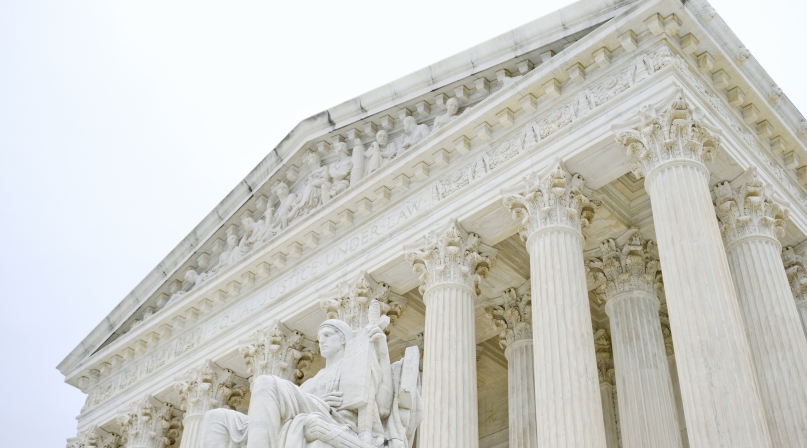Courts ponder the constitutionality of the Universal Service Fund
Author

Seamus Dowdall

Emma Conover
Upcoming Events
Related News

Key Takeaways
On July 24, the U.S. Fifth Circuit Court of Appeals ruled in Consumer’s Research v. FCC that the mechanism underlying the Federal Communications Commission’s (FCC) Universal Service Fund (USF) is unconstitutional. The decision comes on the heels of months of uncertainty in Congress around the long-term fiscal sustainability of the USF, which has operated for nearly 30 years in providing subsidy support for achieving universal service to telecommunications services across the country.
The USF plays a crucial role in providing universal service to communications services and expanding broadband infrastructure, connecting low-income households with affordable internet, providing subsidized internet service to facilities like libraries and schools, and supporting connectivity for rural health care services. The USF relies on a base of traditional cable and telephone provider revenues that is dwindling, due to the continued rise of internet use and adoption to streaming services across the last 15 years in favor of traditional providers' services. Broadband providers are not currently required to contribute to the USF.
On September 30, U.S. Solicitor General Elizabeth Prelogar filed a petition for review with the Supreme Court. While the USF will continue to operate in the short term while legal developments continue, the present situation poses uncertainty for USF programs that include the E-rate program, the Rural Health Care program, the Lifeline program, and the High-Cost Program.
What is the Universal Service Fund? Why does it matter to counties?
The USF has operated in its current form for nearly 30 years under the Telecommunications Act of 1996, which established the goal of increasing access for all consumers at just, reasonable, and affordable rates. Current USF programs include the following, all of which provide direct or indirect benefits to counties and county residents:
- The Lifeline Program: This program helps make communications services including telephone, broadband internet, or bundled voice-broadband package services more affordable for low-income consumers. The program was originally established in 1985 for telephone services and has expanded to cover mobile and broadband services as technology has modernized. The program, although active, is considered a predecessor program to the Affordable Connectivity Program, the authorization of which is a key advocacy goal for NACo.
- The High-Cost Program: This program supports more than a dozen legacy funds that are designed to ensure that consumers in rural, insular, and high-cost areas have access to modern communications networks capable of providing voice and broadband service, both fixed and mobile, at rates that are reasonably comparable to those in urban areas. Recent programs include the 5G Fund for Rural America, the Rural Digital Opportunity Fund, the Connect America Fund, and others.
- The Schools and Libraries (E-Rate) Program: This program makes telecommunications and information services more affordable for schools and libraries, providing discounts for telecommunications, internet access, and internal connections to eligible schools and libraries. Annual funding for this program is capped at $4.15 billion.
- The Rural Health Care Program: This program provides funding to eligible health care providers for telecommunications and broadband services necessary for the provision of health care. Eligible health care providers include local health departments or agencies, community mental health centers, rural health clinics, and other entities. Funding for this program for Fiscal Year (FY) 2024 is $706.9 million.
Collectively, the USF offers a critical support mechanism for broadband services to reach rural, high-cost, and low-income residents through a variety of vital programs.
What changes may come to the USF?
Currently, the FCC funds the USF by charging interstate carriers a percentage of their revenues, which is often passed on to customers as a line-item charge. In Consumer’s Research v. FCC, petitioners argued that the FCC lacked meaningful limits to how much the USF could raise, and that the fee charged more closely resembled a tax. The petitioners argued that due to the separation of powers enacted under Article I of the U.S. Constitution, the FCC and USAC lacked the taxing authority to charge a universal service fee, which rests solely with the legislature.
The ruling thus opens up several avenues for change with the USF. If the Supreme Court chooses to uphold the Fifth Circuit Court's decision, or if it declines to review the ruling entirely, the USF will require immediate Congressional review. Even if the Supreme Court chooses to overrule the Fifth Circuit Court's decision, Congress will have a strong impetus to reform the USF to better align it with the modern broadband market as well as provide legal clarity for the fund's underlying mechanism.
There are several proposals in Congress to monitor. The U.S. Senate has convened a working group on reforming the USF, which is chaired by Sens. Ben Ray Lujan (D-NM) and John Thune (R-SD), and the group is expected to release its findings in the near future. There have also been legislative hearings to discuss expanding the contribution base for the USF beyond traditional carriers to account for changes in the telecommunications marketplace.
NACo supports modernization efforts to the USF that work to preserve the goals of universal service. NACo will continue to monitor developments to the USF and keep members updated accordingly.
Resource
Broadband Task Force: High-Speed Internet Is Essential For All Counties

Related News

NACo Legal Advocacy: William Trevor Case v. State of Montana
The question at hand in William Trevor Case v. State of Montana is how the “emergency-aid” exemption to the Fourth Amendment is defined and whether it should require “probable cause,” a higher legal threshold that would be needed to justify officers entering the premises of a home in an emergency-aid scenario.

County Countdown – Dec. 1, 2025
Every other week, NACo's County Countdown reviews top federal policy advocacy items with an eye towards counties and the intergovernmental partnership.

U.S. House Passes Reauthorization Bill for the State and Local Cybersecurity Grant Program
On November 17, the U.S. House passed a reauthorization bill for the State and Local Cybersecurity Grant Program (SLCGP).